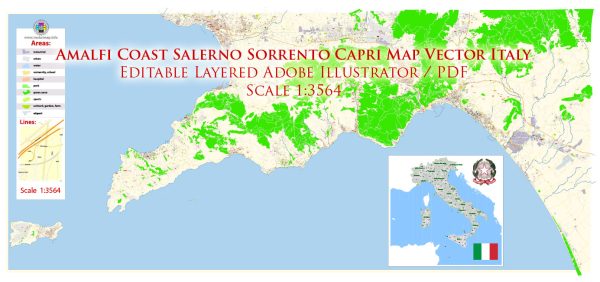The Amalfi Coast, Sorrento, and Salerno are regions in southern Italy with a rich economic history that dates back to ancient times. The economic development of these areas has been influenced by factors such as trade, agriculture, tourism, and industry.
Vectormap.Net provide you with the most accurate and up-to-date vector maps in Adobe Illustrator, PDF and other formats, designed for editing and printing. Please read the vector map descriptions carefully.
1. Ancient and Medieval Periods:
- Amalfi: Amalfi, one of the major towns on the Amalfi Coast, was a maritime republic during the Middle Ages and played a crucial role in Mediterranean trade. It was a key hub for the exchange of goods, especially luxury items like silk, spices, and precious metals. The Amalfitans were skilled sailors and traders, contributing to the prosperity of the region.
- Sorrento: Sorrento has a history dating back to ancient times, with evidence of Greek and Roman influence. It was known for its agriculture, particularly the cultivation of olives and citrus fruits. The Romans established villas in the area, contributing to its economic importance.
- Salerno: Salerno, with its strategic location on the Tyrrhenian Sea, was an important maritime center during the medieval period. It had a renowned medical school and was a center for trade and cultural exchange.
2. Renaissance and Baroque Eras:
- The economic prosperity of the Amalfi Coast and its towns declined during the Renaissance and Baroque eras due to various factors, including political instability and changes in trade routes. However, the region continued to be known for its picturesque landscapes and architectural beauty.
3. Modern Period:
- Agriculture: Throughout the modern period, agriculture remained a significant part of the economy. The terraced hillsides of the Amalfi Coast were used for cultivating grapes, olives, and citrus fruits. Limoncello, a lemon-flavored liqueur, became a popular product of the region.
- Tourism: In the late 19th and early 20th centuries, the Amalfi Coast, Sorrento, and Salerno began to attract tourists drawn to the scenic beauty and cultural heritage. The development of transportation infrastructure, including roads and later highways, facilitated tourism.
- Post-WWII Reconstruction: After World War II, the Amalfi Coast and its surrounding areas underwent reconstruction and economic revival. Tourism continued to grow, and the region became a sought-after destination for both domestic and international visitors.
- Industry: While traditional sectors like agriculture and fishing persisted, industrial activities also developed. Small-scale industries, including craft production and artisanal goods, contributed to the local economy.
4. Contemporary Period:
- Today, tourism is a dominant force in the economy of the Amalfi Coast, Sorrento, and Salerno. The region is known for its luxury hotels, resorts, and the preservation of its cultural and historical sites.
- Agriculture, especially the production of lemons and olives, remains important. The cultivation of lemons is particularly associated with the production of Limoncello, a popular regional beverage.
- Challenges include balancing the benefits of tourism with environmental conservation and maintaining the authenticity of local traditions and culture.
In summary, the economic history of the Amalfi Coast, Sorrento, and Salerno is marked by a transition from maritime trade dominance to a focus on agriculture and, eventually, tourism. The region’s historical significance, coupled with its natural beauty, continues to make it a unique and thriving economic entity in Italy.


 Author: Kirill Shrayber, Ph.D.
Author: Kirill Shrayber, Ph.D.